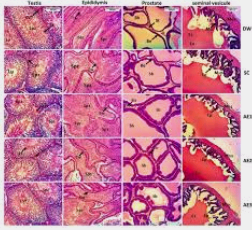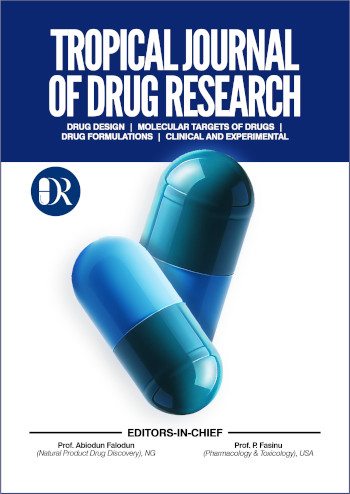Anti-inflammatory and anti-oxidant activities of Schumanniophyton magnificum leaves: In vivo and in vitro approaches
DOI:
https://doi.org/10.26538/tjdr/v1i1.2Keywords:
antioxidant, anti-inflammatory, leukocyte mobilization, vascular permeability, edema, Schumanniophyton magnificum leavesAbstract
Purpose: To investigate the methanol extract of Schumanniophyton magnificum leaves' (MESM-L) anti-inflammatory and antioxidant properties
Methods: Acute toxicity studies were carried out for 24 hours. Albino rats were randomized into five groups for in vivo anti-inflammatory studies using three models namely egg albumin-induced paw edema, acetic acid-induced vascular permeability, and in vivo leukocyte mobilization assay. Groups include the control, standard and experimental groups (100, 200 and 400 mg/kg b.w. of MESM-L). Membrane stabilization and anti-platelet aggregatory response were carried out at the concentrations 0.1 – 0.8 mg/ml. Nitric oxide, 1, 1-diphenyl-2-picrylhydrazyl, and ferric-reducing antioxidant power assays were employed for anti-oxidant studies.
Results: In acute toxicity investigations, MESM-L was found to be non-toxic at the maximum dose of 5000 mg/kg b.w. MESM-L (400 mg/kg b.w) inhibited edema by 73.13% and inhibited vascular permeability by 72.37%. A profound effect of MESM-L on leukocyte mobilization was detected at the lowest dose (41.17%). Inhibition of hemolysis and aggregation of platelets was exhibited with highest concentration of MESM-L on membrane stabilization and anti-platelet aggregatory. MESM-L scavenged NO and DPPH radical- with IC50 values of 19.52 and 12.31 μg/mL in that order. The effect of gallic acid on FRAP assay was found to be higher than MESM-L.
Conclusion: These findings proved the anti-inflammatory potential of MESM-L, although the activities exhibited by the standard drugs were significantly higher. The capacity of the plant to scavenge free radicals is responsible for the effects that have been discovered.
Downloads
References
Ferrero-Miliani L, Nielsen OH, Andersen PS, Girardin SE, Nielsen AG. Chronic inflammation: importance of NOD2 and NALP3 in interleukin-1beta generation. Clin Exp Immunol. 2007;147(2):136-224.
Reuter S, Gupta SC, Chaturvedi MM, Aggarwal BB. Oxidative stress, inflammation, and cancer: how are they linked? Free Radic Biol Med. 2010;49:1603-1616.
Schafer FQ, Quian SY, Buettner GR. Iron and free radical oxidations in cell membranes. Cell Mol Biol. 2000;46:657-662.
Jaiswal SR, Santakke SD. Experimental evaluation of analgesic and anti-inflammatory activity of simvastatin and atorvastation. Indian J Pharmacol. 2012;44(4):475-479.
Mathur R, Velpandian T. Medicinal plant based health: where is the medicinal constituent. Indian J Pharmacol. 2009;41(4):205-206.
Okogun JI, Adeboye JO, Okorie DA. Novel structure of two chromone alkaloids from the root-bark of Schumanniophyton magnificum. Planta Med. 1983;49:95-99.
Akunyili DN, Akubue PI. 1986. Schumanniofoside, the antisnake venom principle from the stem bark of Schumanniophyton magnificum Harms. J Ethnopharmacol. 18:67–72
Houghton PJ, Osibogun IM, Bansal S. 1992. A peptide from Schumanniophyton magnificum with anti-cobra venom activity. Planta Med. 58(3):263–265
Lorke D. A new approach to practical acute toxicity testing. Arch Toxicol. 1983;54(4):275-287.
Winter CA, Risley EA, Nuss GW. Carrageenin induced oedema in hind paw of the rat as an assay for anti-inflammatory drugs. Proc Soc Exp Biol Med. 1962;111:544-547.
Whittle BA. The use of changes in capillary permeability in mice to distinguish between narcotic and non-narcotic analgesics. Br J Pharmacol Chemother. 1964;22:246-253.
Ribeiro RA, Flores CA, Cunha FQ, Ferreira SH. IL-8 causes in vivo neutrophil migration by a cell dependent mechanism. Immunology. 1991;73:472-477.
Shinde UA, Phadke AS, Nair AM, Mungantiwar AA, Dikshit VJ, Sarsf MN. Membrane stabilization activity- a possible mechanism of action for the anti-inflammatory activity of Cedrus deodara wood oil. Fitoterapia. 1999;70:251-257.
Born GVR, Cross MJ. Inhibition of aggregation of blood platelets by substances related to adenosine diphosphate. J Physiol. 1963;166:20-30.
Sreejayan N, Rao MNA. Nitric oxide scavenging by curcuminoids. J Pharm Pharmacol. 1997;49(1):105-107.
Ijoma K.I, Ajiwe, VIE., Odinma. The organic extracts from the leaves of Ficus thonningii Blume, Jatropha tanjorensis J.L Ellis and Saroja and Justicia carnea Lindley as potential nutraceutical antioxidants and functional foods. Trends Phytochem. Res. 2023;7(1): 76-85
Okafor, C.E, Ijoma, K.I., Igboamalu, C.A., Ezebalu, C.E., Eze, C.F., Osita-chikeze, J.C., Uzor, C.E., Ekwuekwe, A.L. Secondary metabolites, spectra characterization, and antioxidant correlation analysis of the polar and nonpolar extracts of Bryophyllum pinnatum (Lam) Oken. BioTechnologia 2024;105 (2): 121–136 .
Akinloye OA, Alagbe OA, Ugbaja RN, and Omotainse SO. Evaluation of the modulatory effects of Piper guineense leaves and seeds on egg albumin-induced inflammation in experimental rat models. J Ethnopharmacol. 2020;255:112762.
Anosike CA, Onyechi O, Ezeanyika LUS. The anti-inflammatory activity of garden egg (Solanum aethiopicum) on egg albumin-induced oedema and granuloma tissue formation in rats. Asian Pac J Trop Med. 2012;20(2):62-66.
Joshua PE, Anosike CJ, Asomadu RO, Ekpo DE, Uhuo EN, Nwodo OFC. Bioassay-guided fractionation, phospholipase A2-inhibitory activity and structure elucidation of compounds from leaves of Schumanniophyton magnificum. Pharm Biol. 2020;58(1):1069-1076.
Ojha D, Mukherjee H, Mondal S, Jena A, Dwivedi VP, Mondal KC, Malhotra B, Samanta A, Chattopadhyay D. Anti-inflamattory activity of Odina wodier Roxb, an Indian folk remedy, through inhibition of toll-like receptor for signaling pathway. PLoS One. 2014;9(8):e104939.
Antonisamy P, Agastian P, Kang C, Kim NS, Kim J. Anti-inflammatory activity of rhein isolated from the flowers of Cassia fistula L. and possible underlying mechanisms. Saudi J Biol Sci. 2019;26:96-104.
Okoli CO, Akah PA, Onuoha NJ, Okoye TC, Nwoye AC, Nworu CS. Acanthus montanus: an experimental evaluation of the antimicrobial, anti-inflammatory and immunological properties of a traditional remedy for furuncles. BMC Complement Altern Med. 2008;8:27-34.
Rosales C. Neutrophil: a cell with many roles in inflammation or several cell types? Front Physiol. 2018;9:113.
Chaitanya R, Sandhya S, David B, Vinod KR, Murali S. HRBC membrane stabilizing property of root, stem and leaf of Glochidion velutinum. Int J Res Pharmaceut Biomed Sci. 2011;2(1):256-259.
Ezekwesili C, Nwodo OFC. Anti-inflammatory activity of Vignia ungiculata seed extract. J Med Lab Sci. 2000;9:141-422.
Blair P, Flaumenhaft R. Platelet alpha-granules: basic biology and clinical correlates. Blood Rev. 2009;23(4):177-189.
Yu J, Su H, Wei S, Chen F, Liu C. Calcium content mediated haemostasis of calcium-modified oxidized microporous starch. J Biomater Sci Polym Ed. 2018;29(14):1716-1728.
Mittal M, Siddiqui MR, Tran K, Reddy SP, Malik AB. Reactive oxygen species in inflammation and
tissue injury. Antioxid Redox signal. 2014;20(7):1126-1167.
Sen A, Batra A. The study of in vitro and in vivo antioxidant activity and total phenolic content of Phyllanthus amanus Schum and Thonn: a medicinally important plant. Int J Pharm Pharm Sci. 2013;5(3):942-947.
Tenuta MC, Deguin B, Loizzo MR, Dugay A, Acquaviva R, Malfa GA, BonesiM., Bouzidi, C., Tundis, R. Contribution of flavonoids and iridoids to the hypoglycaemic, antioxidant, and nitric oxide (NO) inhibitory activities of Arbutus unedo L. Antioxidants. 2020;9:184.
Suluvoy JK, Grace VMB. Phytochemical profile and free radical nitric oxide (NO) scavenging activity of Averrhoa bilimbi L. fruit extract. 3 Biotech. 2017;7:1-10.
Kaur A, Shukla A, Shukla RK. Comparative evaluation of ABTS, DPPH, FRAP, nitric oxide assays for antioxidant potential, phenolic & flavonoid content of Ehretia acuminata r. br. bark. Int Res J Pharm. 2018;9(12):100-104.
Feghhi-Najafabadi S, Safaeian L, Zolfaghari B. In vitro antioxidant effects of different extracts obtained from the leaves and seeds of Allium ampeloprasum subsp. persicum. J HerbMed Pharmacol. 2019;8(3):256-260

Downloads
Published
Issue
Section
License

This work is licensed under a Creative Commons Attribution-NonCommercial-ShareAlike 4.0 International License.




